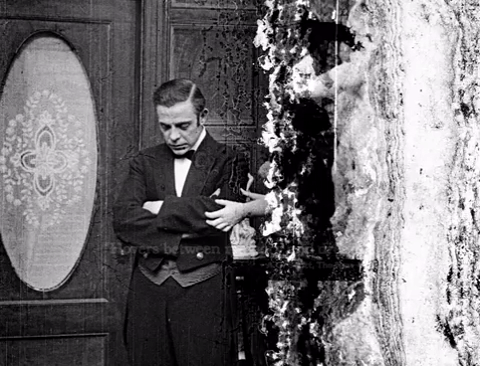Dawson City: frozen time…

(Texte en français plus bas.)
« Dawson City: frozen time » by Bill Morrison
The metaphysics of absence.
More than five hundreds reels of silent nitrate films were dug up in Dawson City in 1978. Films that no one wanted at the time when the cinema met the word of which the interest was obvious and blessed for the business.
Some of these wordless reels were brought to the banks of the Yukon and consecrated in a violent fire that lasted only six hundred seconds. Ten minutes of auto-da-fé ordered by a primo-capitalist god of the gold rush era.
The memory of the moment does not take into account the universal memory. The memory of the moment is ephemeral.
Bill Morisson brings back the scenes featured in those frozen films dating from the beginning of cinema (around 1910-1925). Stories of humans: love, money, murder, art… The reels have partially suffered from the test of time. The film support was damaged and the emulsion was sculpted by moisture and microbes of aging. It added a new stratum to the films, a visual layer that shows up during the screening. What experimental filmmakers have obtained by mechanical methods (scraping of film, direct painting on film…) with the aim of an immediate confrontation, here, the slowness of a five decades long alteration, becomes a disturbing act of creation.
We are attending the festival of organic, alive and boiling forms. The area of the frame occupied by these artifacts is often larger than the surface occupied by the story itself. The passing time invites itself to the film and tells, imposes, its own tale. Death, disguised as a poet, plays its part even if it’s missing in the end credits.
The image of the metamorphosis is highly dramatic and violent because it questions our desire for immortality and shakes its certitude. Until now, we remained confident in the recorded image of ourselves. Until now, filming or taking pictures of someone was the synonym of immortalizing a human.
Without divine intervention, however, the frozen films were resurrected by chance with a backhoe and restored thanks to the human genius.
The end sequence of the Morrison’s film – beautiful and intense – brings the testimony that the material of which the support of the memory is made of, is perishable. As far as is the Human, the hero of his own movie.
©2018 by Tomasz Cichawa
« Dawson City : frozen time » de Bill Morrison
La métaphysique de l’absence.
Plus de cinq cent bobines de films muets sur le support nitrate ont été déterrées à Dawson City en 1978. Des films que nul ne voulait au moment où le cinéma a rencontré la parole dont l’intérêt fut évident et béni pour le business.
Une partie de ces bobines sans mots ont été amenées au bord du Yukon et consacrées dans un feu violent qui n’a duré que six cent secondes. Dix minutes d’autodafé ordonné par un dieu primo-capitaliste de l’ère de la ruée vers l’or. La mémoire de l’instant ne prend pas en compte la mémoire universelle. La mémoire de l’instant est éphémère.
Bill Morisson fait revenir les saynètes tirées de ces films congelés du début du cinéma (env. 1900-1925). Des histoires d’humains : amour, argent, meurtre, art… Les bobines ont partiellement subi l’épreuve du temps. Le support a été abîmé et l’émulsion fut sculptée par l’humidité et des microbes du vieillissement. Il en résulte une nouvelle strate du film, une couche visuelle qui se manifeste lors de la projection. Ce que les cinéastes expérimentaux ont obtenu par des procédés mécaniques (grattage de pellicule, peinture directe sur film…) dans le but d’une confrontation immédiate, ici, la lenteur d’altération de cinq décades, devient un troublant acte de création.
Un festival de formes organiques, vivantes et bouillonnantes se montre à nos yeux. L’espace du cadre occupée par ces artefacts est parfois plus grande que celui de l’histoire elle-même. Le temps qui passe s’invite sur la pellicule et raconte, impose sa propre histoire. La Mort, déguisée en poète, y joue son rôle même si elle n’est pas créditée au générique de fin.
L’image de la métamorphose est hautement dramatique et violente car elle interroge notre désir de l’immortalité et ébranle sa certitude. Jusqu’à maintenant, nous restions confiants en l’image de nous-même enregistrée. Jusqu’à maintenant, filmer ou prendre en photo quelqu’un était le synonyme d’immortaliser l’humain.
Sans intervention divine pourtant, les films congelés ont été ressuscités par chance d’un coup de pelleteuse et restaurés grâce au génie humain. La dernière séquence du film de Morrison – belle et intense – apporte le témoignage que la matière dont est fait le support de la mémoire est périssable. Tout comme l’Humain, le héro de son propre film.
©2018 Tomasz Cichawa